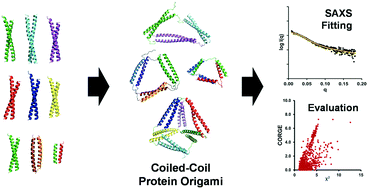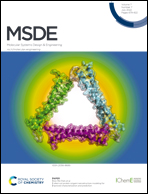Coiled-coil protein origami nanostructure modeling for improved characterization and prediction†
Abstract
Coiled-coil protein origami (CCPO) is a method that genetically links, folds, and assembles coiled-coil protein modules to form well-defined nanostructures. In combination with small-angle X-ray scattering (SAXS), comparative protein structure modeling has been useful to characterize CCPO nanostructures in atomistic resolution. A critical step in the comparative modeling of CCPO nanostructure is structure refinement through molecular dynamics (MD) optimization. However, the details about the MD optimization are not available, and a reliable method to assess the quality of CCPO models is required. Here, we determined the effective length of MD optimization with simulated annealing, which improved the modeling quality. The structure refinement through effective MD optimization resulted in new structural models that nearly matched SAXS data and further enabled computational prediction of the radius of gyration without SAXS data. We used the results to derive a new model evaluation method. Calculation of the error in the radius of gyration for model evaluation significantly improved the predictive power over existing standard methods. The modeling method demonstrated in this study is fast and does not require a high-performance computing resource. Thus, we envision that it will provide great potential for designing new CCPO nanostructures through computational screening and enhanced structure characterization.



 Please wait while we load your content...
Please wait while we load your content...